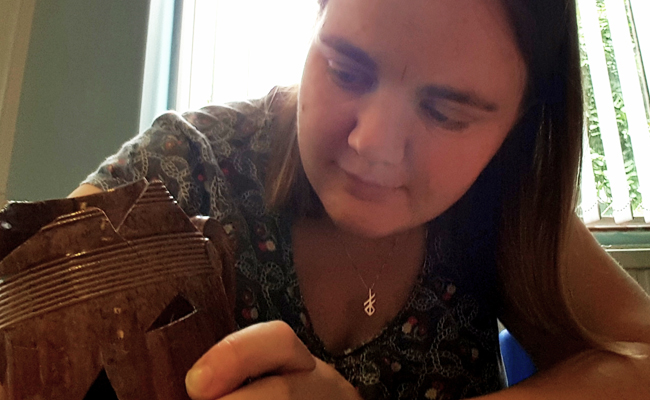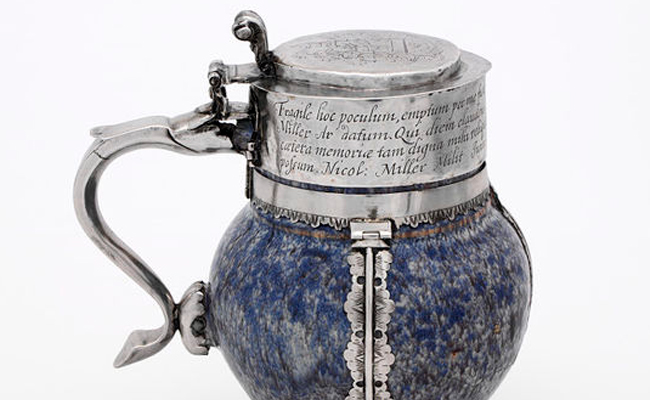
Mug Shot: Getting hands-on with a surviving artefact from Chester.
As the project nears its conclusion, and with data collection from manuscript sources now complete, we’re starting to identify and link to our existing records material artefacts associated with the production, exchange, storage, and consumption of intoxicants. I’m excited to be working on this work package with strand leader Dr Angela McShane; so far we’ve databased around 150 unique objects, a number that will continue to rise in the coming weeks.
The objects we’ve identified are largely related to those listed in the 630 probate inventories (comprising some 30,000 entries) captured by the project, and not only illustrate what a particular object might look like, but also how artefacts themselves could contribute to the social setting in which they were used. Using online museum catalogues and excavation reports from our main areas of study (Norfolk and North West England), we’ve painstakingly identified surviving artefacts that fit the descriptions of objects provided by the inventories, such as glass bottles, earthenware cups, and gilt beakers.

Gilt Trip: Silver beaker with traces of gilt made by William Cobbold in Norwich and presented by Richard Browne, a merchant, to the city’s Dutch Church in Norwich. © Victoria and Albert Museum, London.
Whilst this work enables us to understand what an inventoried object may have represented, it also raises a series of important methodological questions that we needed to address in order to ensure we’re not simply imposing our own identification criteria on the early modern assemblage. Put simply, just because our modern concept of a jug is a large hollow vessel with a pouring lip does, this does not mean this definition would apply in the sixteenth to eighteenth centuries (indeed, we have strong evidence to suggest this is not the case). The problem is further compounded by the development over time of an object terminology by specialists (including art historians, curators, and archaeologists) independent of the object’s historical context and even, at times, each other; thus, the same vessel can be called a jug or mug depending on who is viewing it!

Juggling Terminology: Earthenware jug made in London around 1600 and mounted in silver around 60 years later. The inscription around its top relates its purchase by Nicholas Miller as a present for his great-uncle and his subsequent reception of it as a bequest. © Victoria and Albert Museum, London.
Fortunately, the project has been greatly aided in its identification of objects through the work of seventeenth-century genealogist Randle Holme, who published his Academy of Armory in 1688. Writing from Cheshire (which, serendipitously, is one of the project’s case study areas), he lovingly described particular objects associated with various crafts as well as illustrating them. Thus, in Holme’s work, a beer jug was a vessel with a handle and a rounded belly, a form that is, in some modern publications, known as a mug. Of course, relying on one publication is not without its problems; for example, the glass goblets described in many inventories are almost certainly not the tip of a cow’s horn called ‘by some Gentlemens Buttler’s termed a Souce, or Gogles, or Goblet’ (Holme, Armory, 1688, Book III, Chapter 5, p. 167). In addition, there are some terms Holme does not illustrate, either because he simply omitted them, or because they were not used in early modern Cheshire; objects in this category include the gotch, an extremely large-bellied jug seemingly restricted to East Anglia, where several examples were gifted to church bell ringers (and which crop up regularly in inventories from Norfolk and Suffolk). Despite these difficulties, Holme’s work provides a historical and historicised platform for identifying objects on which the project intends to build.

Neighbourhood Gotch: Gotch presented by Reverend Matthew Bell to the bellringers of St Peter and St Paul’s church, Clare (Suffolk). The crown on the vessel refers to the town’s local hostelry, the Crown Inn, which was owned by Bell’s family. Michael Garlick, (CC BY-SA 2.0).
Whilst objects such as jugs have proven problematic due to our over-familiarity with their meaning and form, other objects are difficult for entirely opposite reasons. For example, terms such as ‘piggin’ and ‘noggin’ are not only rare words in modern parlance (and indeed are only restricted to Cheshire and Lancashire inventories within our dataset), but the forms in question are also made from wood, a perishable material that rarely survives at archaeological sites or within museum collections. Noggin is particularly problematic as it has several definitions, being simultaneously a small drinking vessel, a small bucket, and a measure of alcohol approximating a quarter of a pint (although a single vessel could of course fulfil all these functions).
Inevitably, difficulties over identification and survival mean that it’s simply not possible to accompany all of the intoxicant-related objects described in probate inventories with related objects from the archaeological and museological record. Perhaps most frustrating is the previously noted propensity of some appraisers to only itemise objects of high value, lumping other materials such as ceramics, wood, and glass into generalised categories such as ‘trumpery’, ‘lumber, or ‘wares’. However, it is precisely this category of artefacts that not only formed the largest object assemblages within particular households, but also is the most likely to have survived to the present day (high-value metal wares in particular were often melted down to form new vessels). This is by no means a new problem, but does mean we have to carefully consider the interface between what is presented within an inventory and how this may have matched up to the material reality.

‘Tavern Scene’, by David Teniers the Younger. Note the quantity of ceramic vessels compared to other material types. Wikimedia Commons.
Despite these challenges, the identification of objects is an extremely important part of the project. The artefacts used to produce, traffic, store, and consume intoxicants were as carefully chosen as the substances themselves, so it’s only be documenting these objects, and the locations in which they were found, that it’s possible to fully understand and appreciate the role of alcohol, tobacco, tea, and coffee in early modern society.
Further Reading
- M. C. Beaudry, J. Long, H. Miller, F. Neiman, & G. W. Stone, ‘A Vessel Typology for Early Chesapeake Ceramics: The Potomac Typological System’, Historical Archaeology 17 (1983): 18-42.
- R. Holme, The Academy of Armory (London, 1688).
- O. Kent, ‘Pots and Texts: Understanding Pots in Use’, in J. Allan, N. Alcock, & D. Dawson (eds), West Country Households, 1500-1700 (Woodbridge, 2015), pp. 366-99.
- A. S. Martin, ‘The Role of Pewter as Missing Artefact: Consumer Attitudes toward Tablewares in Late Eighteenth-Century Virginia’, in G. L. Miller, O. R. Jones, L.A. Ross, & T. Majewski (eds), Approaches to Material Culture: Research for Historical Archaeologists (Pennsylvania, 1991), pp. 161-86.
- S. Pennell, ‘‘Pots and Pans History’: The Material Culture of the Kitchen in Early Modern England’, Journal of Design History 11 (1998): 201-16.
- L. Weatherill, Consumer Behaviour and Material Culture in Britain, 1660-1760 (2nd ed., London & New York, 1996).






